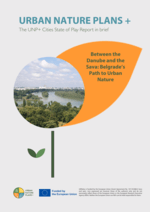
Belgrade State of Play report in brief
This State of Play report summary highlights Belgrade’s first steps towards a nature- and climate-resilient city. With a focus on its rivers, new urban n...
Read more
Belgrade – a city that never stands still. Cafés, street markets, culture, life that goes on late into the night – all of this belongs to the city just as much as the mighty rivers Danube and Sava that shape it. But alongside all this energy, a new idea is taking root: Belgrade is to become more liveable, more nature-focused and more resilient. Initial projects along rivers and in urban neighbourhoods demonstrate how nature, city life and climate protection can come together.
The city is still at the beginning. While other European cities already have master plans for urban nature, Belgrade is only now developing this vision. This opens up the opportunity to learn from others while developing your own locally anchored strategy.
Belgrade is expanding. New residential districts, commercial areas and roads are being built, but space for parks and other open, natural areas is becoming scarce. The city has realised that without parks, trees and nature-friendly riverbanks, it will not only lose quality of life, but also vital protection against heat, heavy rain and flooding.
The rivers play a central role. Along the Danube and the Sava, projects that link nature, recreation and climate protection are emerging. These new open spaces will provide leisure opportunities and serve as natural flood protection zones and habitats for wildlife. Walkways, shady trees and flowering areas could soon characterise the riverbanks.
Even in densely built-up neighbourhoods, things are set to change: schoolyards, squares and small streets could be planted with trees and shrubs to create new places to spend time and mitigate the heat. However, this brings challenges. New natural spaces require maintenance, there is limited space, and climate adaptation costs money. Belgrade is focusing on clear goals, better coordination and long-term planning to achieve this.
Belgrade wants to engage its citizens more effectively. Until now, many projects have been developed mainly within the administration or with international partners, and there have only been a few permanent participation formats. A culture of continuous participation has yet to develop. The new Green Infrastructure Strategy aims to change this by encouraging closer collaboration between the administration, citizens, and private actors.
In the future, workshops and neighbourhood activities will ensure that ideas come directly from the community. The collection and implementation of ideas should combine ecological and social effects, ranging from school gardens to neighbourhood projects. This will transform the concept of urban development, turning anonymous construction projects into community initiatives and grey areas into vibrant places.
The city's goal is to become a place where climate protection, biodiversity, and quality of life are closely linked. To this end, Belgrade is focusing on four key areas:
Long-term funding: Rather than isolated, short-term projects, a reliable framework should be created that will endure for years and decades.
With support from the UNP+ project, Belgrade can learn from other cities' experiences in developing their Urban Nature Plans. How can participation be made truly effective? And how can budgets be secured when political priorities change?
Belgrade is still at the beginning of its transformation. A comprehensive master plan is still lacking, but initial steps have been taken. If Belgrade succeeds in linking vision, data, funding and participation, it could demonstrate in the coming years that a growing, dynamic city can also be liveable and close to nature.
Publishing date: